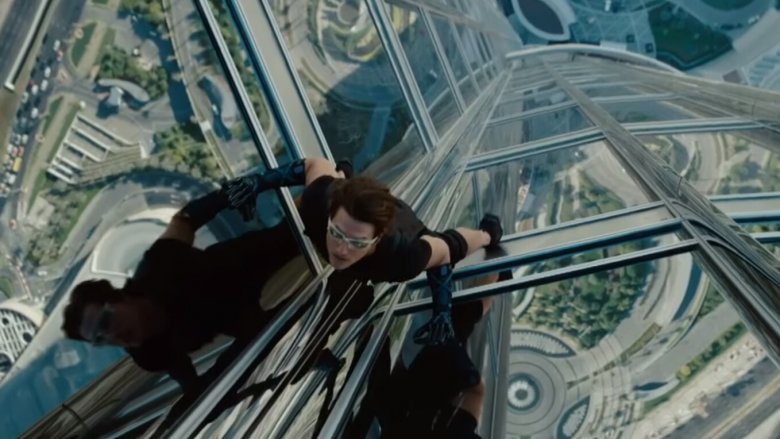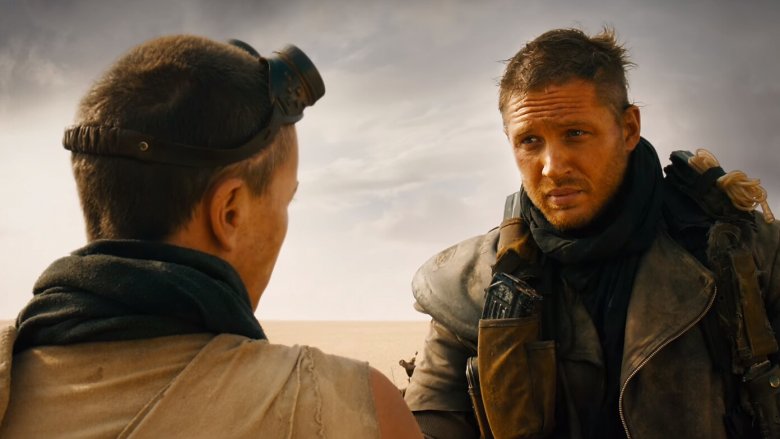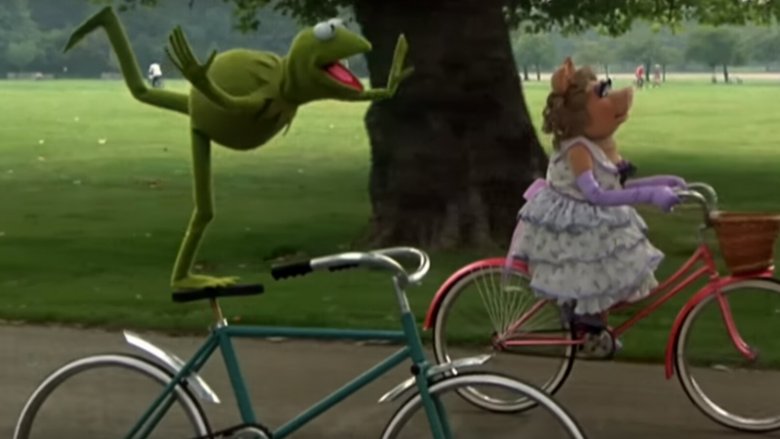Movie Franchises That Consistently Put Out Great Sequels
In the movie industry, the Law of Diminishing Returns reigns supreme. Sequels as crowd-pleasing as their predecessors have always been few and far between — for every Empire Strikes Back, there are three Jaws: The Revenges. Even in the current landscape of massive franchise domination, consistency in long-running series remains rare. The self-perpetuating nature of fandom means some blockbuster follow-ups keep getting churned out, even if no one seems to really like them.
That's why it's particularly impressive when a series manages to achieve a hot streak of multiple solid entries. We scoured cinema history for the most consistent franchises we could find, looking for series that had at least three successful sequels in a row. Some received critical acclaim, others maintained audience approval, and a few became cult favorites years after release. Finding worthy choices was no easy task, but we've rounded up ten movie franchises that consistently put out great sequels.
Mission: Impossible
Mission: Impossible has been a film series for so long now that many people might forget that it started as a reboot of a '60s TV show. Tom Cruise has been playing Impossible Missions Force agent Ethan Hunt since 1996, and hasn't slowed down (or aged, it would seem) since. Despite a trio of big-name directors (Brian De Palma, John Woo, and J. J. Abrams), the first three Mission films received mixed reviews.
It was 2011's Ghost Protocol that signaled Mission: Impossible's rise to the top tier of action franchises. The first live-action film from director Brad Bird (best known for The Iron Giant and the Incredibles movies), Ghost Protocol wowed crowds and critics with fresh, stylish action sequences. Rogue Nation followed and fared nearly as well — well enough that Christopher McQuarrie became the first director to return for a second Mission. Fallout dropped into theaters to another round of acclaim and ticket sales, causing some to opine that Hunt has even eclipsed James Bond.
James Bond
With 24 movies over the course of six decades (and no end in sight), there may be no single character looming larger over pop culture history than James Bond. 007 first stormed from the pages of Ian Fleming's novels to the silver screen in 1962's Dr. No. The now-iconic Bond elements may not quite have been all in place right away, but it wasn't long before the sequels perfected the formula.
The tenure of original big-screen Bond Sean Connery is still held up by many fans as the peak of the series. Despite some social politics that are a pretty big strike against them today, the trio of From Russia With Love, Goldfinger, and Thunderball sparked a global phenomenon and remain classics of the action genre. Over the following decades, the movies evolved along with tastes and trends in an ongoing effort to give audiences what they want.
Roger Moore's time as 007 was less consistent, as the splashy spectacle of the 1970s brought some crowd-pleasers and some outright duds. But another hot streak came during the transition from Timothy Dalton to Pierce Brosnan, as The Living Daylights, License to Kill, and GoldenEye found the franchise rebuilding Bond for a post-Cold War era with shifting morals. Daniel Craig's run has also been pretty successful, proving that Bond, like diamonds, might be forever.
Harry Potter
Speaking of global phenomena, J.K. Rowling's Harry Potter books were an unprecedented crossover hit that captured the imaginations of kids and adults alike. It was inevitable, then, that the series would become a blockbuster film franchise, and the results were, quite simply, magic. Over the course of a decade, the world of Hogwarts came to life with the help of an army of talented filmmakers, including brilliant designers and one of the finest collections of character actors in modern history.
All eight Harry Potter movies enchanted critics and fans alike. After director Chris Columbus laid a book-faithful foundation with the first two films, Alfonso Cuarón and Mike Newell explored new stylistic avenues in years four and five. David Yates then took the reins of the series going forward, bringing a consistent vision to Order of the Phoenix, The Half-Blood Prince, and The Deathly Hallows. The seventh and final book was split into two films, allowing the filmmakers to finish Harry's story with extra nuance and narrative scale. In fact, Deathly Hallows Part 2 holds the highest Rotten Tomatoes ranking of the entire series.
Star Wars
If there's one thing that's pretty much always been consistent about Star Wars fans, it's that they rarely agree about Star Wars. Whatever your favorite or least favorite entry in the franchise, you're likely to encounter someone who will argue passionately for the opposite take. Even the prequels, after years as critical punching bags, are starting to see a reappraisal from a generation who grew up with them.
There was no shortage of skepticism when Disney, after purchasing Lucasfilm from its founder and namesake, set out to relaunch Star Wars with an armada of new movies. But The Force Awakens was a smash, satisfying fan nostalgia while introducing a diverse young cast of new characters immediately embraced by audiences. Rogue One introduced the concept of Star Wars "spinoff" films with a fresh, gritty take on the galaxy. And The Last Jedi received massive critical acclaim (whether or not every "fan" agreed) for its stylish and sometimes metatextual dissection of the Skywalker legacy. Even Solo: A Star Wars Story, for all its behind-the-scenes issues and its underwhelming box office performance, managed a solid hit with critics and audiences.
Fast and Furious
The road to iconic status for the Fast and Furious franchise has been full of strange and unexpected quarter-miles. The first four entries were critically panned, and just successful enough financially to keep a little gas in the tank. The tales of small-time street racing outlaws went through cast shuffles, a soft reboot, and a reunion as they spun their wheels in search of their true calling.
Then came Fast Five, which elevated the stakes to the level of a global heist adventure, pulled its cast together into a likable and devoted team, and threw in Dwayne "The Rock" Johnson as a nemesis who becomes an unlikely ally. It worked. Fast & Furious 6 doubled down, continuing to win over critics and gather new fans by deepening the bond among "the Family" while pitting them against terrorists with tanks. But the masterpiece of the series arrived with Furious 7, which shattered box office records, brought its action to new heights, and left not a dry eye in the house.
The eighth Fast movie, Fate of the Furious, was slightly less acclaimed than its trio of predecessors, but hype for the series has hardly diminished. Fate solidified Luke Hobbs and Deckard Shaw as such fan-favorite characters that the Rock and Jason Statham were handed their own spinoff.
Mad Max
There are few movies that seem less likely to have spawned a decades-long series with worldwide acclaim than Mad Max. Writer/director George Miller's first feature (starring a young and unknown Mel Gibson) is a weird, micro-budget punk-pulp romp that initially did very little business outside of its native Australia upon its release in 1979. Little did anyone realize at the time the storm that Miller had conjured.
What jumpstarted Max as an iconic series was Mad Max 2, released in the United States as simply The Road Warrior to avoid relying on the mostly unknown original. Ramping up the style of its post-apocalyptic setting and channeling the spirit of classic spaghetti westerns, Road Warrior inspired a generation of filmmakers. In the aftermath of its success, Mad Max Beyond Thunderdome followed with a bigger budget, a grander scale, and a delightfully over-the-top performance from Tina Turner. It took a full 30 years for Miller to return to Max's wasteland again, but when he did, Mad Max: Fury Road was hailed as an action masterpiece as technically flawless as it was thematically relevant.
The Muppets
Jim Henson's Muppets have remained a beloved all-ages institution for many reasons, not the least of which is their readiness for reinvention. The 1970s variety show that made Kermit and friends household names set a stage where anything could happen, giving the troupe of characters (and their performers) an opportunity to put on whatever kind of show struck their fancy. This freewheeling spirit followed the Muppets to the big screen when The Muppet Movie kicked off a film series characterized by variety.
The Muppet movies aren't really sequels in the traditional sense. Rather, each one is a chance for the characters to put on a different kind of show, and that freshness has helped make most of them family classics, particularly those released in the '80s and '90s. The original Muppet Movie, an old-fashioned road picture, was followed quickly by The Great Muppet Caper, a fourth wall-breaking mystery farce. Next came The Muppets Take Manhattan, a bittersweet piece that found the gang going their separate ways, only to reunite for a Broadway musical. After Henson's untimely death in 1990, the troupe carried on with a pair of well-received adaptations of literary masterpieces, The Muppet Christmas Carol and Muppet Treasure Island.
Child's Play
The horror genre is rife with franchises that creep on and on, refusing to die. Every slasher flick or monster mash that does decent business seems to be followed by a line of brainless follow-ups shambling on like lifeless corpses of the original. It's shocking, then, that one of the sillier premises ever to carve out a spot in the Halloween pantheon unleashed a series that not only lives up to first film, it keeps on growing increasingly clever and fun. Calling it "consistently great" may be somewhat controversial, but its devotion to staying fresh against all odds makes it worthy of mention.
After the third Child's Play movie landed with a thud, Chucky the killer doll went into hibernation for a few years before being reborn in Bride of Chucky. Bride became a box office hit by embracing its own bizarre existence and going full black comedy. The outlandish follow-up, Seed of Chucky, was less well received, but has gathered a cult following in the years since. Another reinvention followed with Curse of Chucky and Cult of Chucky, two stylish and smart direct-to-video thrillers that are actually the best-reviewed entries in the series' 30-year history.
Godzilla
Sometimes, greatness can be measured simply by cultural impact, and it's hard to argue with Godzilla's status as one of the world's greatest movie stars. "The Big G" holds the Guinness World Record for the longest continuously running movie franchise, having sold over 100 million tickets in his native Japan alone since he first rose from the sea in 1954. That original film is actually a somber thriller that expresses the country's lingering fear that nuclear horror could return to their home at any time, something that might surprise people who are more familiar with Godzilla's showdown with Charles Barkley.
Not every Godzilla movie is as serious as the original, and few are as well-respected. But it's a sign of the series' strength that nemeses like Mothra, Rodan, and King Ghidorah have become almost as iconic as the green guy himself. The appearances of these sequel stars in the trailer for the upcoming American production of Godzilla: King of the Monsters sparked massive hype among kaiju fans. And if you need any further convincing of the franchise's greatness, the Criterion Collection acquired the rights to 13 of the sequels for release on their art film streaming service FilmStruck, with a Blu-ray boxed set potentially on the horizon.
George Romero's "Dead" series
Zombies are big business, not only on the big screen but television, comic books, video games, and pretty much anywhere else you can squeeze a shambling, ravenous corpse. There is no question, though, that the subgenre's prevalence can be traced back to the works of filmmaker George A. Romero. It's also hard to disagree that anyone has done it better.
Romero's 1968 masterpiece Night of the Living Dead is a monolithic influence on zombie fiction for good reason. It's remarkable for its inventiveness, its effectiveness, and its ongoing cultural relevance. But Romero continued to explore his visions of a necrotic apocalypse throughout the decades to come, always using his zombies to comment on social issues of the day. The first three follow-ups to Night were especially successful. 1979's Dawn of the Dead satirized consumerism, Day of the Dead took a hard look at militarism in 1985, and Land of the Dead skewered economic inequality 20 years later. They all remain classics because they wrap their hard-hitting political themes in thrilling, nightmarish entertainment.










